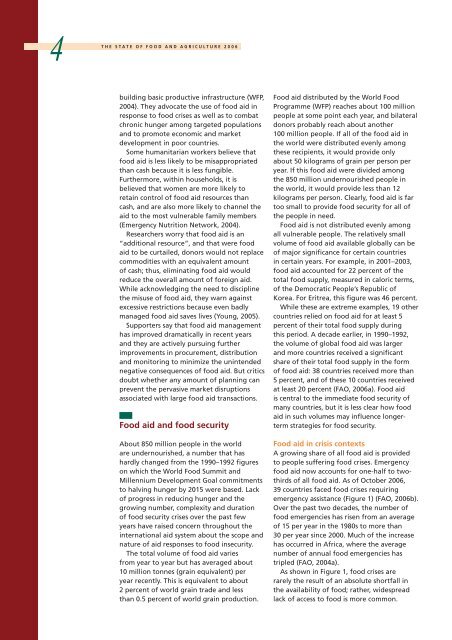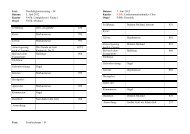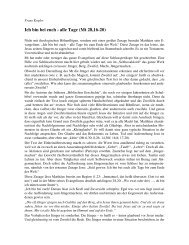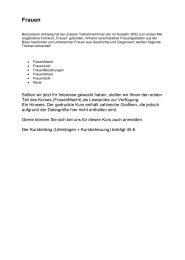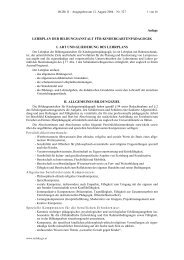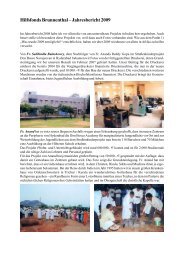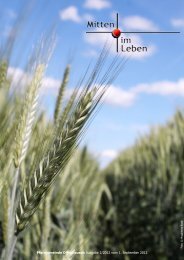The State of Food and Agriculture - FAO
The State of Food and Agriculture - FAO
The State of Food and Agriculture - FAO
Create successful ePaper yourself
Turn your PDF publications into a flip-book with our unique Google optimized e-Paper software.
4<br />
THE STATE OF FOOD AND AGRICULTURE 2006<br />
building basic productive infrastructure (WFP,<br />
2004). <strong>The</strong>y advocate the use <strong>of</strong> food aid in<br />
response to food crises as well as to combat<br />
chronic hunger among targeted populations<br />
<strong>and</strong> to promote economic <strong>and</strong> market<br />
development in poor countries.<br />
Some humanitarian workers believe that<br />
food aid is less likely to be misappropriated<br />
than cash because it is less fungible.<br />
Furthermore, within households, it is<br />
believed that women are more likely to<br />
retain control <strong>of</strong> food aid resources than<br />
cash, <strong>and</strong> are also more likely to channel the<br />
aid to the most vulnerable family members<br />
(Emergency Nutrition Network, 2004).<br />
Researchers worry that food aid is an<br />
“additional resource”, <strong>and</strong> that were food<br />
aid to be curtailed, donors would not replace<br />
commodities with an equivalent amount<br />
<strong>of</strong> cash; thus, eliminating food aid would<br />
reduce the overall amount <strong>of</strong> foreign aid.<br />
While acknowledging the need to discipline<br />
the misuse <strong>of</strong> food aid, they warn against<br />
excessive restrictions because even badly<br />
managed food aid saves lives (Young, 2005).<br />
Supporters say that food aid management<br />
has improved dramatically in recent years<br />
<strong>and</strong> they are actively pursuing further<br />
improvements in procurement, distribution<br />
<strong>and</strong> monitoring to minimize the unintended<br />
negative consequences <strong>of</strong> food aid. But critics<br />
doubt whether any amount <strong>of</strong> planning can<br />
prevent the pervasive market disruptions<br />
associated with large food aid transactions.<br />
<strong>Food</strong> aid <strong>and</strong> food security<br />
About 850 million people in the world<br />
are undernourished, a number that has<br />
hardly changed from the 1990–1992 figures<br />
on which the World <strong>Food</strong> Summit <strong>and</strong><br />
Millennium Development Goal commitments<br />
to halving hunger by 2015 were based. Lack<br />
<strong>of</strong> progress in reducing hunger <strong>and</strong> the<br />
growing number, complexity <strong>and</strong> duration<br />
<strong>of</strong> food security crises over the past few<br />
years have raised concern throughout the<br />
international aid system about the scope <strong>and</strong><br />
nature <strong>of</strong> aid responses to food insecurity.<br />
<strong>The</strong> total volume <strong>of</strong> food aid varies<br />
from year to year but has averaged about<br />
10 million tonnes (grain equivalent) per<br />
year recently. This is equivalent to about<br />
2 percent <strong>of</strong> world grain trade <strong>and</strong> less<br />
than 0.5 percent <strong>of</strong> world grain production.<br />
<strong>Food</strong> aid distributed by the World <strong>Food</strong><br />
Programme (WFP) reaches about 100 million<br />
people at some point each year, <strong>and</strong> bilateral<br />
donors probably reach about another<br />
100 million people. If all <strong>of</strong> the food aid in<br />
the world were distributed evenly among<br />
these recipients, it would provide only<br />
about 50 kilograms <strong>of</strong> grain per person per<br />
year. If this food aid were divided among<br />
the 850 million undernourished people in<br />
the world, it would provide less than 12<br />
kilograms per person. Clearly, food aid is far<br />
too small to provide food security for all <strong>of</strong><br />
the people in need.<br />
<strong>Food</strong> aid is not distributed evenly among<br />
all vulnerable people. <strong>The</strong> relatively small<br />
volume <strong>of</strong> food aid available globally can be<br />
<strong>of</strong> major significance for certain countries<br />
in certain years. For example, in 2001–2003,<br />
food aid accounted for 22 percent <strong>of</strong> the<br />
total food supply, measured in caloric terms,<br />
<strong>of</strong> the Democratic People’s Republic <strong>of</strong><br />
Korea. For Eritrea, this figure was 46 percent.<br />
While these are extreme examples, 19 other<br />
countries relied on food aid for at least 5<br />
percent <strong>of</strong> their total food supply during<br />
this period. A decade earlier, in 1990–1992,<br />
the volume <strong>of</strong> global food aid was larger<br />
<strong>and</strong> more countries received a significant<br />
share <strong>of</strong> their total food supply in the form<br />
<strong>of</strong> food aid: 38 countries received more than<br />
5 percent, <strong>and</strong> <strong>of</strong> these 10 countries received<br />
at least 20 percent (<strong>FAO</strong>, 2006a). <strong>Food</strong> aid<br />
is central to the immediate food security <strong>of</strong><br />
many countries, but it is less clear how food<br />
aid in such volumes may influence longerterm<br />
strategies for food security.<br />
<strong>Food</strong> aid in crisis contexts<br />
A growing share <strong>of</strong> all food aid is provided<br />
to people suffering food crises. Emergency<br />
food aid now accounts for one-half to twothirds<br />
<strong>of</strong> all food aid. As <strong>of</strong> October 2006,<br />
39 countries faced food crises requiring<br />
emergency assistance (Figure 1) (<strong>FAO</strong>, 2006b).<br />
Over the past two decades, the number <strong>of</strong><br />
food emergencies has risen from an average<br />
<strong>of</strong> 15 per year in the 1980s to more than<br />
30 per year since 2000. Much <strong>of</strong> the increase<br />
has occurred in Africa, where the average<br />
number <strong>of</strong> annual food emergencies has<br />
tripled (<strong>FAO</strong>, 2004a).<br />
As shown in Figure 1, food crises are<br />
rarely the result <strong>of</strong> an absolute shortfall in<br />
the availability <strong>of</strong> food; rather, widespread<br />
lack <strong>of</strong> access to food is more common.


